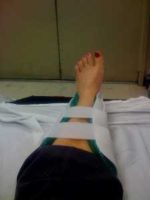14 May Drug Holidays From Osteoporosis Meds Linked to More Broken Bones
MedicalResearch.com Interview with:
 Brittany Bindon, MD
Brittany Bindon, MD
Department of Internal Medicine
University of Chicago
Chicago, Illinois
MedicalResearch.com: What is the background for this study?
Response: Bisphosphonates are commonly used in the treatment of osteoporosis, however, they have been associated with rare, severe side effects such as osteonecrosis of the jaw and atypical femoral fractures.
As a result, bisphosphonate drug holidays have become common in clinical practice though currently, there are minimal data on the safe duration of these drug holidays. We sought to further characterize the clinical and laboratory parameters associated with increased fracture risk in patients on bisphosphonate drug holiday.
MedicalResearch.com: What are the main findings?
Response: 15% of patients in our study developed a fracture (including both osteoporotic and non-osteoporotic fractures) during follow up. The yearly incidence of fractures ranged from 3.7-9.9%, peaking at 9.9% and 9.8% during years 4 and 5, respectively. Patients who developed fractures tended to be older with lower BMDs at baseline.
MedicalResearch.com: What should readers take away from your report?
Response: Patients should be closely monitored during bisphosphonate holidays, specifically to evaluate for fractures. Patients should be regularly advised on fall precautions, as these are the major risk factor for development of fractures.
MedicalResearch.com: What recommendations do you have for future research as a result of this work?
Response: Given the risk of fractures during drug holidays, it would be worthwhile to conduct a large prospective study to evaluate how long of a holiday is needed to reduce the risk of these rare adverse events.
Citations:
OSTEOPOROTIC FRACTURES DURING BISPHOSPHONATE DRUG HOLIDAY
Brittany Bindon, William Adams, Neelam Balasubramanian, Jasmin Sandhu and Pauline Camacho
Endocrine Practice Feb 2018, Vol. 24, No. 2 (February 2018) pp. 163-169
[wysija_form id=”3″]
The information on MedicalResearch.com is provided for educational purposes only, and is in no way intended to diagnose, cure, or treat any medical or other condition. Always seek the advice of your physician or other qualified health and ask your doctor any questions you may have regarding a medical condition. In addition to all other limitations and disclaimers in this agreement, service provider and its third party providers disclaim any liability or loss in connection with the content provided on this website.
Last Updated on May 14, 2018 by Marie Benz MD FAAD
